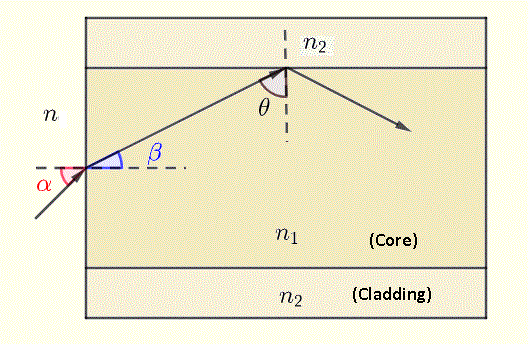

The optical fiber system shown below has a core of refractive index n1 and a cladding of refractive index n2 such that n1 > n2. For a light ray to be internally reflected at the core - cladding interface, the angle on incidence θ must be greater than the critical angle θc given by


A numerical aperture of optical fibers calculator is included in this site and may be used to check the calculations in the following problems.
let n = 1, n1 = 1.46 and n2 = 1.45 in the diagram of the optical fiber system above. Find
a) the critical angle θc at the core - cladding interface.
b) the numerical aperture N.A. of the optical fiber
c) the angle of acceptance αmax of the the optical fiber system.
Solution to Problem 1
a) θc = sin-1 (n2 / n1) = sin-1 (1.45 / 1.46) = 83.29 °
b) N.A. = √(n21 - n22) = √(1.462 - 1.452) = 0.17
c) αmax = sin-1√(1.462 - 1.452) = 9.82 °
We use the same values for n , n1 and n2 in the diagram of the optical fiber system above as those used in problem 1. Let the angle of incidence of a light ray on the outside - core interface be α = 5°. Find
a) angle of refraction β at the outside - core interface.
b) angle θ
c) and explain why this light ray will be reflected at the core - cladding interface and hence guided along the fiber.
Solution to Problem 2
a) Angle β is found using Snell's law at the outside - core interface as follows
n sin(α) = n1 sin(β)
Substitute the given parameters from problem 1 to obtain
β = sin-1 ( sin(5°) / n1) = 3.42 °
b) Angle θ is complementary to angle β hence
θ = 90 - 3.42 = 86.58 °
c) The angle of incidence θ = 86.58 ° at the core - cladding interface is larger that the critical angle θc = 83.29 ° calculated in problem 1 above and will therefore be totally reflected at this interface and hence guided along the fiber.
Of course we could have answered this question by stating that since angle α = 5° is smaller to αmax = 9.82 ° calculated in problem 1, the given light ray will be reflected at the core - cladding interface, but the idea behind this problem is to gain better understanding of the concept of numerical aperture and angle of acceptance of an optical fiber systems using numerical values and calculations at each interface.
let n = 1 and n1 = 1.48 in the diagram of the optical fiber system above. Find n2 such that light rays incident at an angle α greater than 12 ° are not reflected at the core - cladding and therefore not guided along the optical fiber system.
Solution to Problem 3
In this problem, we are given αmax = 12 ° given by the formula
αmax = sin-1(√(n12 - n22)/ n)
The above is equivalent to
sin(αmax) = √(n12 - n22)/ n
Substitute αmax, n and n1 by the given values and calculate n2
n22 = n12 - sin2(αmax)
n2 = √(1.482 - sin2(12°)) = 1.465
let n = 1 in the diagram of the optical fiber system above. Find n1 and n2 such that the acceptance αmax = 10° and the critical angle at the core - cladding interface θc = 82 ° .
Solution to Problem 4
In this problem, we are given αmax and θc whose formulas are given by
\( \alpha_{max} = \sin^{-1} \left (\dfrac{1}{n} \sqrt{n_1^2-n_2^2} \right) \)
and
\(\theta_c = \sin^{-1} \left(\dfrac{n_2}{n_1} \right) \)
Take the sine of both sides in the formula of \( \alpha_{max} \)
\( \sin \left(\alpha_{max}\right) = \sin \left(\sin^{-1} \left (\dfrac{1}{n} \sqrt{n_1^2-n_2^2} \right) \right) \)
Simplify using the identity \( \sin (\sin^{-1} (x)) = x \)
\( \sin \left(\alpha_{max}\right) = \dfrac{1}{n} \sqrt{n_1^2-n_2^2} \)
square both sides to obtain
\(\sin^2\alpha_{max} = \left (\dfrac {n_1^2-n_2^2} {n^2} \right) \)
Take the sine of both sides in \(\theta_c = \sin^{-1} \left(\dfrac{n_2}{n_1} \right) \) and simplify to obtain
\(\sin \theta_c = \left(\dfrac{n_2}{n_1} \right) \)
Substitute the known values to obtain the equations
\(n_1^2-n_2^2 = n^2 \sin^2 \alpha_{max} \quad\quad (equation 1) \)
\(\dfrac{n_2}{n_1} = \sin \theta_c \quad\quad (equation (2) \)
Equation (2) gives
\(n_2 = n_1 \sin \theta_c \)
Substitute the above in equation (1) and solve for n1 and n2
\(n_1^2- (n_1 \sin \theta_c )^2 = n^2 \sin^2 \alpha_{max} \)
Rewrite the above as
\(n_1^2(1 - \sin^2 (\theta_c)) = n^2 \sin^2 \alpha_{max} \)
Solve for \(n_1^2 \)
\(n_1^2 = \dfrac{\sin^2 \alpha_{max} }{1 - \sin^2 \theta_c} = n^2 \dfrac{\sin^2 \alpha_{max}}{ \cos^2 \theta_c } \)
Take the square root of both sides in the above
\(n_1 = \dfrac{n\sin \alpha_{max} }{ \cos (\theta_c)} \)
Use equation 2 to find
\(n_2 = n_1 \sin \theta_c = \dfrac{n \sin(\alpha_{max})}{ \cos \theta_c} \sin \theta_c = n \sin \alpha_{max} \tan \theta_c \)
Substitute n , θc and αmax by their values to obtain numerical values for n1 and n2
\(n_1 = \dfrac{\sin 10^{\circ} }{ \cos 82^{\circ}} = 1.2477 \)
and
\(n_2 = \tan 82^{\circ} \sin 10^{\circ} = 1.2355 \)
Optical Fibers.
numerical aperture of optical fibers calculator
Total Internal Reflection of Light Rays at an Interface.
Refraction of Light Rays, Examples and Solutions.